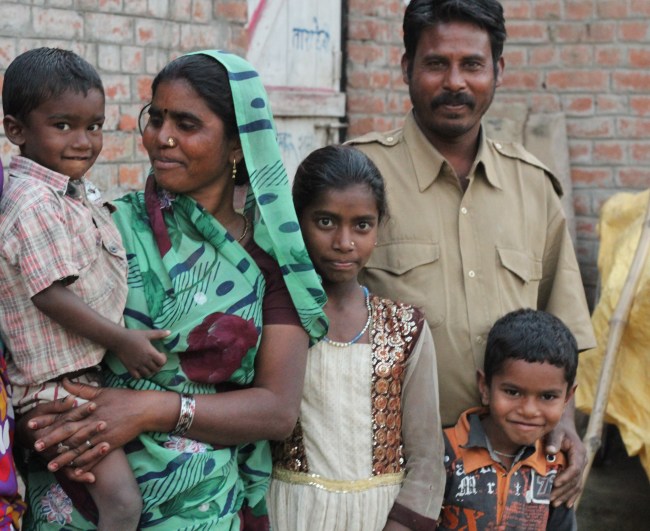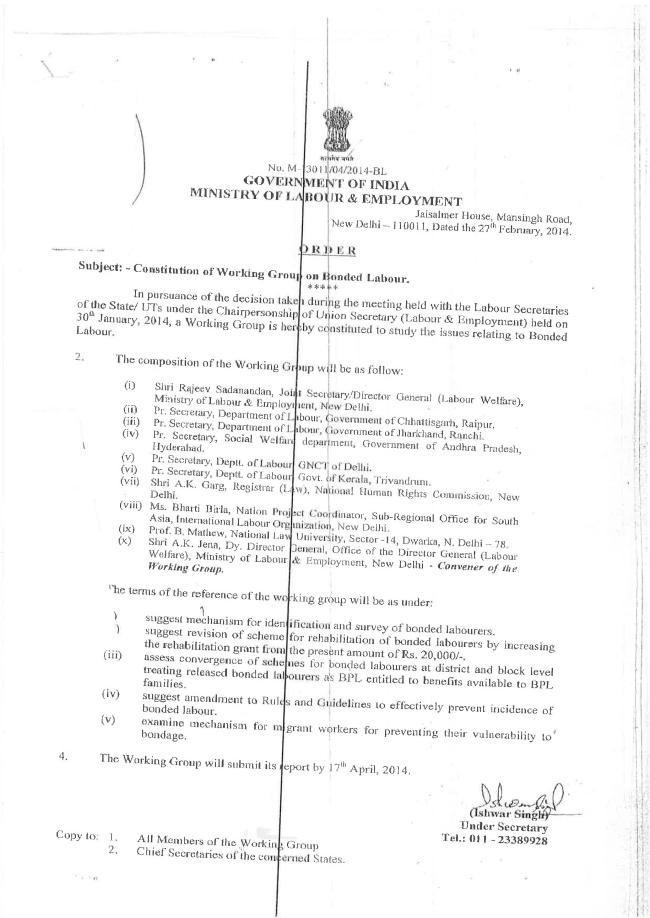
In rural Uttar Pradesh, less than 50 km west of India’s holy city, Varanasi, Satish and Tulsi* have spent the last four years learning how to live in freedom. They are raising three children in the hamlet where they grew up, but Satish lives with the hope that his kids’ childhood memories will be different. “I didn’t have anything. Now my kids can go to school,” said Satish, a 32 year old farmer who has overcome twenty years of captivity as a bonded labourer.
A Childhood in Bondage
Toward the back of the hamlet, if you look beyond the trees, you cannot miss the tall smoke stack that dominates the horizon. This chimney belongs to a brick kiln that was the dreadful prison where Satish and Tulsi spent the waking hours of their childhood. Tulsi is 28 years old today – soft-spoken but unwavering. She guesses that she was about 5 or 6 years old when her father was approached by a man who told him, “Come work for me. You won’t have to work too hard.” Tulsi’s father had been lured from one upper caste brick kiln owner to another, and by simply giving his word, he was locked into a verbal obligation to the owner. Just like that he gave up his rights and his family. Tulsi and her relatives – uncles, aunts and cousins – were sent to work at that brick kiln behind the hamlet. From then on, Tulsi’s life would be ruled by fear and the heavy hand of a master that treated the family as his own property. Every time they tried to leave, he threatened them with a debt he claimed they owed.
Duped by the owner’s deception, the family became bonded labourers. They were paid far below minimum wage – just Rs. 30-40 a day – and could not even dispute the owner’s wage register because they were illiterate. Within the first two years of work, life took a turn for the worst when Tulsi’s father fell ill. Already poor and now unable to work, he faced the prospect of marrying off his daughter. “Nobody was there to earn, so he said, ‘From where I will get money for the marriage?’,” Tulsi recalled. When Tulsi was eight years old, her father married her off to a cousin, 10-year-old Satish, whose family also worked at the same brick kiln. Married as children and forced to work, Tulsi and Satish were denied any semblance of a childhood. Satish laughed incredulously when he was asked about school. There was no school for them. “We never got permission from the slave owner,” said Satish.
Wake up before 3am. Cook roti on the communal earthen stove and then carry it off to eat on the way to the brick kiln. That was how the work day began. Twelve-hour long shifts in the hot sun without a break for meals were the norm. Sometimes the workers were permitted to return to the hamlet in the afternoon, only to return to the owner in the evening for domestic or agricultural work in the fields until 10pm. Even children as young as 3 years old were forced to work. If they could lift a brick, they were made to work. Tulsi hauled the sand that was mixed in the clay used to make the bricks. She said the work was meant for buffaloes. She routinely watched workers carry 5 to 6 bricks at a time on their heads – back and forth from the work space where bricks were stacked meters high, to the tractor that shipped off the stock. A four-person team was expected to load one tractor with 8000 bricks every single day. They had to make the daily quota for delivery at whatever the physical cost to their hands and bodies. Tulsi recalls how everyday activities became difficult. The same raw hands that handled hot bricks fresh from the furnace were used to painfully scoop spicy vegetable curry into hungry mouths. The families were not bound by chains but they didn’t have to be. Bonded labourers are bound to their owners, often forced to work up to 18 hours daily and restricted from the freedom to find alternative work.
“We used to say we want to leave, but I was not in the control of my parents. We were controlled by the employer,” said Tulsi.
Tulsi said it was fear that kept her going. It wasn’t uncommon to witness a horrifying scene that would keep her from getting sleep at night. Rest is not an option when your life is run by an unforgiving and greedy slave master. One night Satish was working late, loading bricks into the tractor. As he lifted brick after brick, he heard the shrill cries of his brother-in-law getting beat up by the brick kiln owner’s henchmen after his attempt to run away. In a senseless act of brutality, the owner had the man lie down and then jumped on his chest. He died one month later. The very thought of escaping cast palpable fear into every worker. Tulsi vividly remembers the death threats, “Your cousins have died from my hand. All of you will die by my hands. I control you.” There was no law at the brick kiln. Whatever the owner said was the command. “He told us that nobody will support [your caste]. If you will be killed, I will kill you. If you work, you will have to work for me only,” recalled Satish. Not a single person escaped the inhuman treatment. On the few occasions the workers were given permission to get medical attention, they would be given a loan from the owner. Loans increased the debt, and in the absence of any other form of income, the slaveholder assumed ownership over the bonded laborers.
Vigilant Communities Lead to Freedom
Hope came in 2009 through the dedication of a man who came to visit the hamlet every day. By that time, Satish and Tulsi had known the life of slavery for nearly two decades, and had given birth to their two eldest children while in captivity. The visiting man taught them about their rights and about the law. He would tell them, “The law isn’t only for the rich and powerful. It’s also for you – low caste and poor. The law is equal for everyone.” The man was a field worker with MSEMVS, an NGO based in Varanasi. MSEMVS is a sub-partner to Free the Slaves, an International Justice Mission partner organization. Since 2012, the IJM National Interventions initiative has been identifying and partnering with like-minded NGOs to accelerate the work of ending slavery throughout India.
“The people in the village were living such a life that all they did was work. Outside life had no meaning for them. Their owner was everything,” says Bhanuja Sharan Lal, director of MSEMVS.“They were trapped in the belief that there was nobody who could help them and nowhere they could go.”
MSEMVS was working in villages outside of Varanasi to set up community vigilance committees intended to empower residents in vulnerable communities and teach them about the dangers of bonded labour and trafficking. The organization educates villagers about how they could invoke the Bonded Labour (System) Abolition Act, 1976 and demand fair wages for their work. By educating members of vulnerable communities and monitoring their work, the community vigilance committees created by MSEMVS work to bring sustainable freedom to vulnerable communities.
These kinds of community groups can also be a functioning example for the government-appointed vigilance committees that every district and sub division must set up by law. According to the law, every district of India must form vigilance committees to advise District Magistrates on how to curb the rate of bonded labour. “The main function of the vigilance committee is…to survey the prevalence of bonded labour to ensure that [bonded labourers] are released, and for those released, through rehabilitation, don’t get trapped in bonded labour again,” explains Shri Sharan. Without active vigilance committees to monitor bonded labour, entire communities remain vulnerable to this form of modern day slavery.
After months of building trust, Satish joined the community vigilance committee and became empowered enough to do something drastic. One early morning in January 2010, he and two other labourers secretly set out to go to the MSEMVS office in Varanasi. The risks were enormous: they were so scared they crawled through tall wheat fields to hide themselves during the getaway. With help from MSEMVS, the three workers went directly to the District Magistrate’s office to file their complaint against the abusive brick kiln owner, demanding freedom and protection. The authorities responded quickly and all of the families in Satish’s hamlet were liberated the next day. The adults received release certificates, granting them legal emancipation and physical protection from the brick kiln owner, as well as rehabilitation funds that help released bonded labourers make the transition to independence.
“Both government and non-governmental organizations have to work together to ensure they feel safe and receive what they are entitled to so that they can live free lives and become rehabilitated members of society,” explains Shri Sharan. MSEMVS advocated for the released bonded labourers to help them access government schemes and reintroduce them into society. “None of us had any identity or voter card earlier,” said Satish. The residents of Satish’s hamlet now have ration cards and work under the MGNREGA. “Our condition has been changed for better.”
Freedom For All
As a community leader, Satish has taken on a prominent role in his village’s community vigilance committee. He and Tulsi want to help other bonded labourers learn how to use their voices to secure their rights and rightful freedom. “We want every person to be free like us. We wish that bonded labour should be removed from this world,” said Tulsi.
Satish remembers the days when residents of the village would be punished with beatings if they were caught earning extra rupees after their shift in the brick kiln. Today they are free to work as they like. Satish leads agricultural projects in his village. The twenty families are constructing a community pig farm that will help provide a steady source of income. Satish is one of the men in charge of the piggery. When we met him, he was feeding the pigs and toting around his youngest son. The same calloused hands that lifted bricks into tractors now tenderly hold his son. Women and children in the hamlet have also received a second chance at life. The women are empowered through self-help groups that meet regularly, and children are free to get an education. Wearing their school uniforms, Satish and Tulsi’s two oldest children respectfully bow down to touch their parents’ feet before heading off on an early morning. Providing their children the education they were denied is an accomplishment that these parents would have only dreamed of before their rescue from slavery four years ago. “Our life has been changed,” said Tulsi. “The best thing is that we can see the faces of our children every morning and evening, which was not possible earlier.”
*A pseudonym














